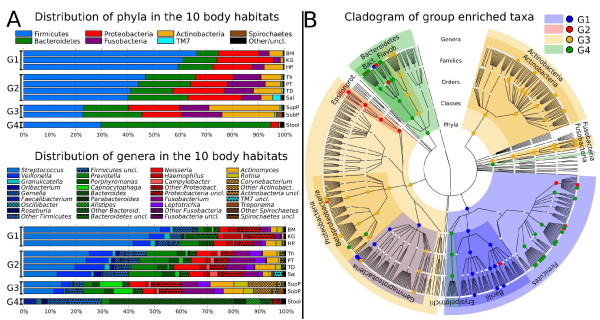Figure 1.
Groups detected in the sampled digestive tract microbiome sites based on similarities in microbial composition. (a) Taxonomic composition of the microbiota in the ten digestive tract body habitats investigated based on average relative abundance of 16S rRNA pyrosequencing reads assigned to phylum (upper chart) and genus (lower chart). Microbiota from the ten habitats are grouped based on the ratio of Firmicutes to Bacteroidetes as follows: Group 1 (G1), buccal mucosa (BM), keratinized gingiva (KG) and hard palate (HP); Group 2 (G2), throat (Th), palatine tonsils (PT), tongue dorsum (TD) and saliva (Sal); Group 3 (G3), supraginval (SupP) and subgingival plaques (SubP); and Group 4 (G4), stool (Stool). Labels indicate genera at average relative abundance ≥2% in at least one body site. The remaining genera were binned together in each phylum as 'other' along with the fraction of reads that could not be assigned at the genus level as 'unclassified' (uncl.). See Additional file 1 for detailed values. (b) Circular cladogram reporting taxa consistently differential among the body habitats in at least one group detected using LEfSe. Colors indicate the group in which each differential clade was most abundant. See Additional file 3 for the detailed list of taxa whose representation was statistically different among the groups. The representation is based on RDP phylogenetic hierarchy.

